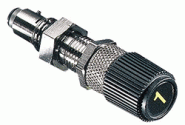Top 5 Tips for Selecting Valves
Which valve to choose? With so many valves on the market, go through this list step by step to narrow your choices.
- What's your application? Manual valves include ball, check, diaphragm, elliptic, metering, needle, pinch, plug, pressure relief, and stopcock valves. Actuated valves include electrically actuated ball, elliptic, pinch, proportioning, and general-purpose solenoid valves. Read the description for each to see if a particular type will work with your application.

Cole-Parmer® Brass Metering Valve
- What fluid type (liquid or gas) is compatible with valve materials?PTFE withstands many harsh or corrosive chemicals. For safety reasons, always use metal valves for pressurized gases.
- What is the temperature, pressure, and flow rate you will be using? Generally, metal valves can stand higher temperatures and pressures than plastic valves.
- What span of time will the valve be in use? Choose normally closed or normally open depending on the state the valve will be in most often. For solenoid valves, consider response time and length of time valve will be energized. Continuous (100%) duty solenoid valves are best for frequent on/off cycling.
- What are your maintenance requirements? Ball valves resist plugging and are easiest to service.
Comentarios
Publicar un comentario